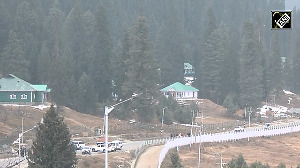Global consultants tracking the Indian economy and even institutions within the country have tried to identify the areas where they have noticed disparities between the new growth numbers and the reality as they assess it, says AK Bhattacharya.

The new national income numbers produced by the Central Statistics Office (CSO) have elicited two kinds of reaction.
At one level, there has been general appreciation of the CSO's efforts at improving data coverage and adopting standards that bring India's statistics, for instance on gross domestic product or GDP, in line with those followed in most other countries.
But at another level, doubts about the credibility of the new numbers have been raised and criticisms have been quite sharp, arising mainly out of the obvious disconnect between the new GDP numbers and most other indicators of economic activities.
Global consultants tracking the Indian economy and even institutions within the country have tried to identify the areas where they have noticed disparities between the new growth numbers and the reality as they assess it.
For instance, Emerging Advisors Group has listed 12 economic indicators and compared their movements during India's high-growth phase of 2005 and 2006 with those in the second half of 2014.
These indicators include agricultural and industrial output, credit growth, electricity generation, cement production, vehicle sales, freight traffic growth, exports, corporate sales and revenues of listed companies and the government.
The comparison has brought out startling results. In respect of most of the indicators, the movements in the latter period (second half of 2014) have been much lower than those in 2005 and 2006.
The argument is that if the growth under the new CSO numbers is relatively higher now, then these economic indicators too would have shown a corresponding rise as they did during India's high-growth phase in 2005 and 2006.
The sharp divergence, therefore, is puzzling, even though some of the difference could be attributed to the fact that while the economic indicators are based on volumes, the CSO's economic growth numbers are based on value addition and they now capture value addition in a more comprehensive way.
But still the divergence is not fully explained and doubts about the new CSO numbers remain.
Even some domestic institutions have questioned the credibility of the new growth numbers.
For instance, the sharp divergence in manufacturing sector growth has come under close scrutiny.
Under the old data, manufacturing growth was estimated at 1.3 per cent in 2012-13.
The sector shrank by 0.8 per cent in 2013-14 and recovered marginally with growth of 1.2 per cent in the April-December period of 2014.
In sharp contrast, the manufacturing sector, based on the new CSO numbers, grew at 6.2 per cent in 2012-13, 5.3 per cent in 2013-14 and 6.8 per cent in the first nine months of 2014-15.
If this gap is due to the fact that the new GDP numbers have used a larger database of corporate results, then the question is whether the revised numbers were validated by usual methods of cross-checking and consultation.
There are a few more areas of discomfort from the new numbers.
For instance, the revised numbers show growth in financial, real estate and professional services at around 14 per cent in the first three quarters of 2014-15.
It is a puzzle that why this growth should be so high when real estate activities have slowed in this period and professional services too have not seen the kind of growth that such data can support.
Doubts have also arisen on account of the new GDP methodology's stress on including gross value added numbers for calculating the growth rate.
What, however, is not clear as to how the different trends in prices, values and volumes are reconciled in the new GDP data. An increase in the sale of air-conditioners may suggest increased activity.
But how will the data account for a situation when these are sold at lower prices on account of discounts?
It would be interesting to find out whether the CSO's preliminary findings about the new GDP data were shared with other key economic ministries in the government before they were made public.
Did the CSO, for instance, have any prior consultation with the finance ministry to, at least, seek some validation of their findings?
More importantly, what data collection discipline was followed by the CSO to arrive at these numbers?.
Politically, of course, the new GDP numbers are likely to help the present government in projecting a revival of growth with greater ease than would have been possible otherwise.
The Narendra Modi government is already using the new figures to claim how the Indian economy is now growing at a rate faster than China.
India may well be growing faster than China, but it would be reasonable to doubt whether India's growth rate is indeed over 7.4 per cent in the current year.
More than six weeks have gone by since the new GDP data were announced by the CSO.
In spite of the many doubts and questions raised about the data sets, the government is yet to respond to them with satisfactory explanations or clarifications.
The promised explanatory notes on the new data are yet to materialise.
Instead, there is an uneasy sense of calm and indeed a hint of smugness within the government when it is confronted with such questions.
The approach seems to be that let the months pass by and doubts about the new data too would disappear.
Since, there is simply no option to what has been dished out, domestic institutions and international bodies would accept them as they are.
That approach, if true, would be unfortunate and certainly damage India's credibility with numbers both at home and abroad.











